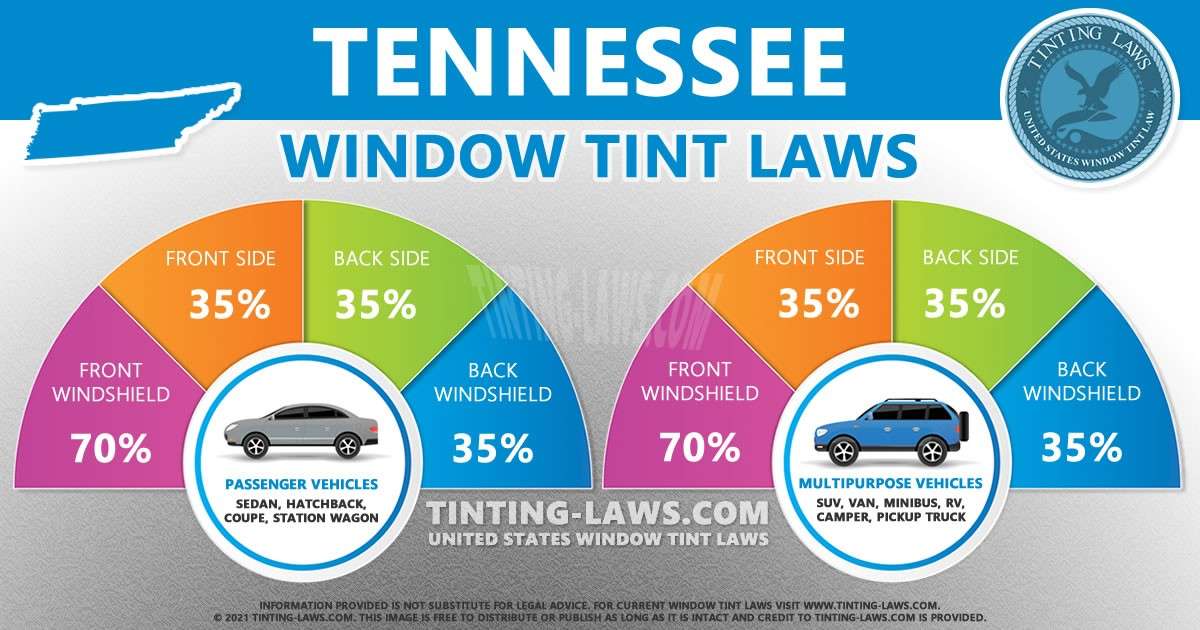What Tint Is Legal In Tennessee

Alright folks, let's talk window tint in Tennessee. It might seem straightforward, but there are specific regulations you need to know to stay legal and avoid getting pulled over. Think of this guide as your trusty workshop manual for understanding Tennessee's tint laws.
Why This Matters: Staying Legal and Safe
Understanding tint laws isn't just about avoiding fines. It's about safety. Illegal tint can significantly reduce visibility, especially at night or in poor weather. This can increase your risk of accidents. This guide will help you understand the legal limits, so you can tint your windows while remaining within the bounds of the law and prioritizing safety. Also, knowing the legal limits can save you money down the road, preventing you from having to pay for tint removal or fines.
Key Specs and Main Parts: VLT is King
The most important term you need to know is Visible Light Transmittance (VLT). VLT is the percentage of visible light that passes through the tinted window. Lower VLT means darker tint. Tennessee law specifies the minimum VLT allowed for each window. It’s not about the darkness added, but the total light allowed through after tinting.
Here's a breakdown of the legal VLT percentages in Tennessee:
- Windshield: Non-reflective tint is allowed above the AS-1 line, or the top 5 inches, whichever is shorter. No other tint is allowed on the windshield.
- Front Side Windows: Must allow more than 35% VLT.
- Back Side Windows: Any darkness is allowed.
- Rear Window: Any darkness is allowed, provided the vehicle is equipped with side mirrors.
It's crucial to note that these are the minimum percentages. You can have lighter tint (higher VLT) than these, but not darker.
Beyond VLT, Tennessee law also addresses reflectivity. Reflective tint is generally prohibited on the front side windows. Any tint must be non-reflective.
Decoding the Specs: Understanding the Terms
Let's break down some of the terms we've used:
- VLT (Visible Light Transmittance): As mentioned, the percentage of light that passes through the window. A 50% VLT tint lets half of the light through.
- AS-1 Line: A marking on your windshield indicating the safe area for tinting. It's usually a horizontal line located near the top of the windshield.
- Non-Reflective Tint: Tint that doesn't reflect light. This is important because reflective tint can create glare for other drivers.
How It Works: The Mechanics of Tint Laws
The tint laws are enforced based on measurements taken by law enforcement using a light meter. This device measures the VLT of the window and compares it to the legal limits. If the VLT is below the legal limit, you could receive a citation.
It's important to remember that the factory tint on some vehicles can affect the final VLT after aftermarket tint is applied. For example, if your factory glass has a VLT of 70%, applying a 35% VLT film will result in a final VLT lower than 35%. It's always best to consult with a professional tint installer who can measure your vehicle's existing VLT and recommend tint options that will keep you within legal limits.
Real-World Use: Troubleshooting and Practical Tips
Troubleshooting common tint issues:
- Bubbling or peeling tint: This is usually caused by poor installation or low-quality film. The solution is to have the tint removed and reapplied with high-quality film by a reputable installer.
- Hazy or blurry vision: This can be caused by low-quality film or improper cleaning. Use a non-ammonia based cleaner designed for tinted windows.
- Scratches: Avoid using abrasive cleaners or cloths on tinted windows. Use a soft microfiber cloth and a gentle cleaning solution.
Tips for staying legal:
- Research local tint laws: Laws can change, so it's always a good idea to check the latest regulations before tinting your windows.
- Choose a reputable installer: A professional installer will be familiar with the local laws and can help you choose the right tint for your vehicle.
- Ask for a VLT reading: Before leaving the installer, ask them to measure the VLT of your windows to ensure they are within legal limits.
- Keep documentation: Some installers provide documentation showing the VLT of the tint film they used. Keep this in your vehicle in case you are stopped by law enforcement.
Safety Considerations: What to Watch Out For
The main safety concern with window tint is reduced visibility. Dark tint can make it difficult to see at night or in low-light conditions. This can increase your risk of accidents, especially when making turns or backing up.
Also, be aware that removing old tint can sometimes be tricky and may damage the rear defroster lines on your back window. If you're unsure how to remove tint properly, it's best to leave it to a professional.
Finally, consider your own health. Installing window tint involves working with adhesives and chemicals. Wear appropriate safety gear, such as gloves and a respirator, to protect yourself from harmful fumes and contact with skin.
Final Thoughts
Window tint can enhance the look and comfort of your vehicle, but it's important to do it safely and legally. By understanding the Tennessee tint laws and following these guidelines, you can enjoy the benefits of window tint without risking fines or compromising your safety. Remember, **visibility is key**!
To help you even further, we have a detailed diagram outlining all the legal tint percentages for Tennessee. This diagram can be a valuable tool for planning your tint project and ensuring compliance with the law. Contact us to download the diagram, and feel free to reach out if you have any further questions.
